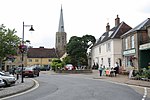Wickham Market Hoard

The Wickham Market Hoard is a hoard of 840 Iron Age gold staters found in a field at Dallinghoo near Wickham Market, Suffolk, England in March 2008 by car mechanic, Michael Dark using a metal detector. After excavation of the site, a total of 825 coins were found, and by the time the hoard was declared treasure trove, 840 coins had been discovered. The coins date from 40 BC to 15 AD. The hoard was described as "the largest hoard of British Iron Age gold coins to be studied in its entirety", and was also significant in providing "a lot of new information about the Iron Age, and particularly East Anglia in the late Iron Age". It was the largest hoard of staters to be found since the Whaddon Chase Iron Age hoard in 1849. In June 2011, the hoard was purchased by Ipswich Museum for the sum of £316,000.
Excerpt from the Wikipedia article Wickham Market Hoard (License: CC BY-SA 3.0, Authors, Images).Wickham Market Hoard
Deben Court, East Suffolk
Geographical coordinates (GPS) Address Nearby Places Show on map
Geographical coordinates (GPS)
| Latitude | Longitude |
|---|---|
| N 52.15 ° | E 1.367 ° |
Address
Deben Court
Deben Court
IP13 0TN East Suffolk
England, United Kingdom
Open on Google Maps








